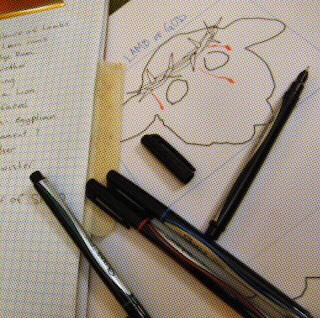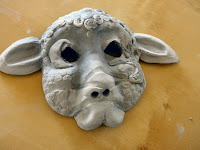When I started the project, I decided to make 3 of each design. Fire and clay being what they are, I knew I could expect some breakage or other mishaps along the way, and I didn't want to pin my success on just one of each.
After everything was glazed and fired, I chose the ones I felt represented my vision most successfully and sent those off to the show.
They may be purchased at the gallery for the run of the show.
I then went back and chose the next most successful set of masks and have listed them in my Etsy shop. These masks were all made at the same time, using the same firing and glazing techniques, and are perfectly fine. Just not quite "show quality". They are priced the same as the masks in the gallery.
The third set is incomplete and some are not quite up to the standards I've set for myself.
hey - you make nearly 100 pieces, they are not all going to be successful.
many of those third pieces will be destroyed. Most of the others will stay here with me as my personal art.
I won't be making another series like this.
The one exception being an occasional mask as a fundraising donation to one of my favorite causes, New Moon Farm goat rescue. Beyond that, the masks in this series will be retired.
If you would like to purchase one of the masks, you have 2 ways to do so:
 ~ Visit the Blue Line Arts gallery in Roseville, Ca during the run of this show:
~ Visit the Blue Line Arts gallery in Roseville, Ca during the run of this show:405 Vernon Street, Suite 100
Roseville, CA 95678
(916) 783-4117
The show runs November 21, 2013 through Dec 28, 2013.
Reception December 21, 2013, 6:00 pm - 9:00 pm.
If you can't make the show, you may purchase a mask in my Etsy shop:
https://www.etsy.com/shop/theSquarePeg
Masks not sold at the show will most likely be available at my regular gallery, or directly from me, via my website :
Thank you so much fir your support and encouragement during this project!
CMCK
CMCK

















































